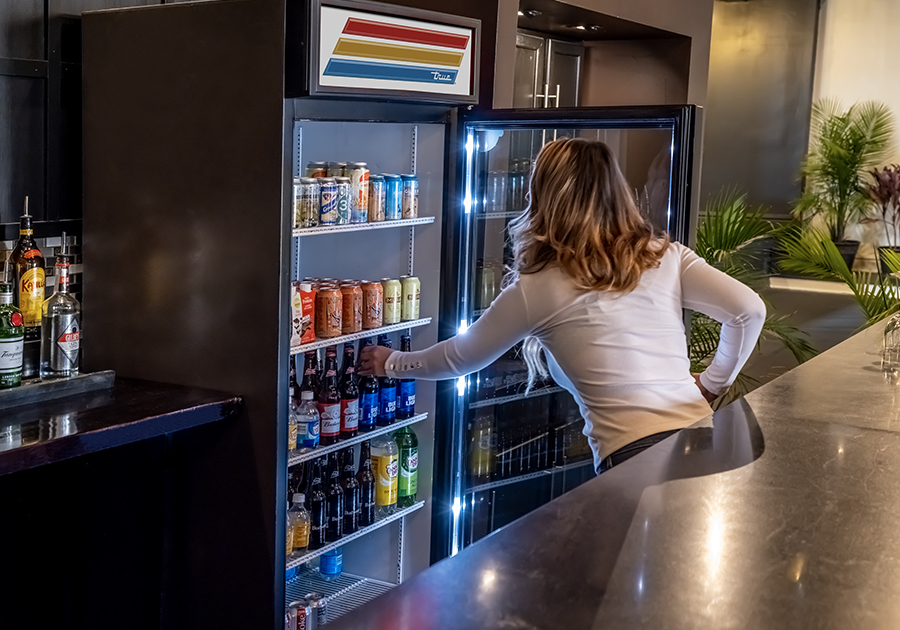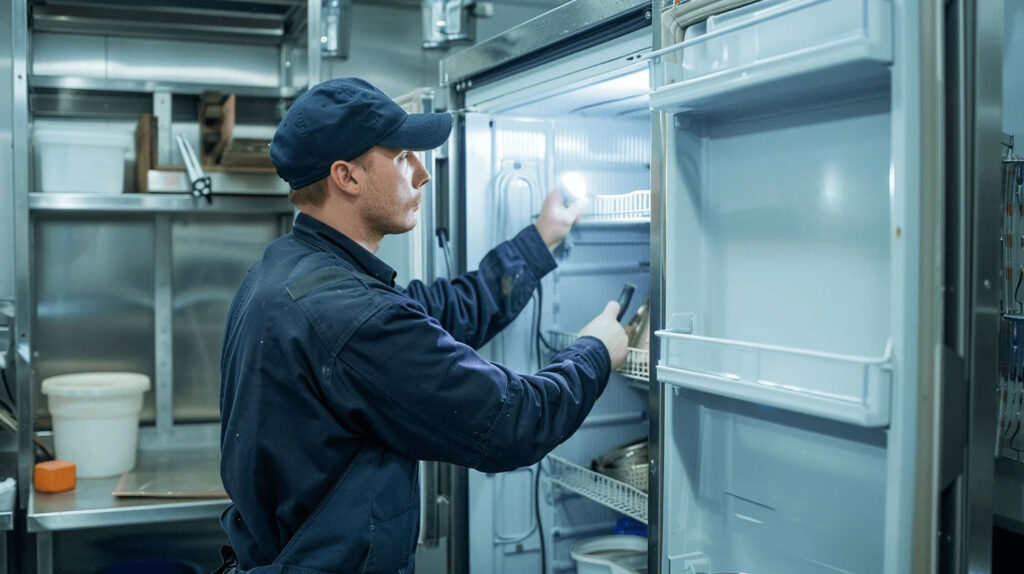Be a Freeze-dom Fighter with These Top 5 Commercial Refrigeration Maintenance Tips for Ultimate Performance

When you invest in a commercial refrigerator, you are buying a significant piece of kitchen equipment. In many ways, commercial refrigerators, whether reach-in or under-the-counter units are the backbone of your operation.
Your refrigeration system keeps your food safe and fresh for customers. A well-maintained refrigerator helps you prevent food waste, preserve ingredients, and maximize the life of meal components. But how do you keep your refrigerator running smoothly and efficiently?
Here are the top 5 commercial refrigeration maintenance tips to ensure your fridge gives optimal performance.
1. Build a Solid Maintenance Foundation for a Clean Chill of Health
How many times have you tried to troubleshoot equipment in your kitchen, only to find that you don’t have the right history, model details, or other crucial information? It happens to all of us. Here’s how to make sure you have what you need.

Gather and Thoroughly Review the Manufacturer’s Guidelines
No one loves reading manufacturer materials and guidelines, but that “light reading” will help you build up a knowledge bank of what needs to be done. The guidelines can offer you essential info on the proper maintenance suggestions, operation, and best cleaning procedures.
Familiarizing yourself with these materials can also protect your investment by helping you avoid mistakes that could void your warranty (or otherwise damage your equipment). Keep the manuals readily accessible, in case you need a quick reference.
Schedule Regular Inspections
A regular professional checkup is good for your health—it’s also good for your commercial refrigerator’s health! Schedule regular preventative maintenance check-ins to assess the components, especially the compressor (the heart of the refrigeration system).
Compressor inspections should include a stop, look, and listen approach. Check out any unusual noises, test the temperatures, and check the seals for signs of wear and tear. Regular inspections can help you prevent minor problems from becoming major (costly) repairs.
Create a Routine Maintenance Calendar
As a general rule, calendars are essential tools for helping you keep track of all the tasks around your kitchen. Put your refrigerator maintenance tasks on your calendar, including:
- Cleaning condenser coils
- Checking door seals
- Inspecting electrical connections
Train your staff on these points as well. That way, you’ll hold each other accountable for keeping your maintenance schedule.
Documenting Maintenance Activities
On a similar note, the best way to get activities done on a regular basis is to implement a system to document when you or your team completes a maintenance task. A basic log should outline the date, the task, issues identified, and room to check off and initial the job. Good documentation can help you note when and if things start to go awry.
2. Accidents Happen, So Address Common Refrigeration Problems Proactively
Similar to preventative maintenance, it’s important to address problems right away. Stop minor problems from escalating by taking care of them when they’re still manageable. It’s much easier to fix a refrigerator door seal now than to deal with a burnt-out compressor down the road.

Conduct Regular Temperature Checks
Checking the fridge’s temperature requires more than just looking at the thermostat. By using a calibrated thermometer, you’ll check the temperature’s accuracy and make sure that you’re meeting food safety standards.
Notice a sudden fluctuation? Investigate any surprise changes immediately, no matter how slight. Keeping a close eye on your refrigerator’s performance and safety is important.
Keep a Log of Issues and Resolutions
Just as you log your regular maintenance actions, you should also keep a log of any larger maintenance issues that arise. Memories can be faulty, and it can be difficult to pinpoint “when” your fridge started making that weird noise or how you fixed that issue six months ago. The log is also handy for audits and equipment assessments.
Train Staff to Recognize Potential Issues
Your staff works in the weeds and may be the first to notice potential refrigeration problems. Review the common warning signals (unusual noises, frost buildup, frequent cycling) and encourage them to report the concerns right away. Your team is your first line of defense to maintain your equipment.
Develop a Troubleshooting Guide
You know your equipment. Creating a troubleshooting guide for staff will empower them to address issues right away. Include steps for diagnosing and resolving common problems like temperature fluctuations, ice buildup, and strange noises. (And when it’s time to call a professional.)
Establish a Protocol for Escalating Maintenance Issues
On that same note—not every refrigeration issue has a DIY solution. There are many times when it’s wise to seek the guidance of a professional technician. Sometimes, “hacking” together a quick fix can even void your warranty and lead to bigger issues in the future. Make your guidelines clear-cut so staff knows when and who to contact.
3. Fridge the Gap with Improved Energy Efficiency
The energy efficiency of your refrigeration equipment is imperative—not just for your utility bills and bottom line, but for extending the life of your equipment. By enhancing the energy efficiency of your commercial refrigeration unit, freezer, blast chiller, and other equipment, you’ll reduce the wear and tear on your machines. You’ll also avoid escalating energy costs.

Conduct an Energy Audit
An energy audit is an assessment of your system’s energy usage. A professional auditor can evaluate your equipment, checking on the power use, effectiveness of insulation, and overall operational efficiency of the unit. The inspector will share a valuable report with actionable recommendations to boost the energy performance of your equipment and overall kitchen.
Implement Energy-Saving Practices
Energy-saving practices don’t have to be a big pain. Add them to your daily habits and routine to maximize efficiency. Installing LED lighting and arranging your kitchen so that cooling equipment is away from heating equipment will help lower the temperature of the space—letting your refrigerator run more efficiently.
Keep your temperature settings as consistent as possible and check them regularly to ensure that the thermostat setting gives an accurate reading.
Regularly Clean Coils and Fans
Dust, dirt, grease, and kitchen debris build up on the back of your commercial refrigeration unit, particularly on the condenser, coils, and fans. When there’s dust in the way, commercial refrigeration systems have to work harder and use more energy. Keep all areas of the fridge clean for optimal performance.
Invest in Energy-Efficient Equipment Upgrades
If you’re in the market for a new reach-in freezer, cooler, or refrigeration unit, view it as an investment in your business. It’s worth getting the best equipment you can afford. High-efficiency compressors, advanced insulation materials, and smart temperature controls can help reduce your energy consumption and make for long-term savings on your energy bills and maintenance. Look for the ENERGY STAR® certification, which indicates the unit is energy efficient.
Educate Staff on Energy-Saving Practices
There’s no shame in being the “close the refrigerator door” person. Remind staff of energy-saving best practices like keeping the door closed, organizing storage to reduce demands on cooling equipment, and reporting any concerns and malfunctions, where everyone contributes to the efficient operation of your refrigeration system. Small regular efforts add up fast for savings.
4. Dressed to Chill: Implement Effective Cleaning Procedures
Grime, dirt, and bacteria are the enemies of your kitchen. Unfortunately, the corners and crevices of your kitchen equipment provide an ideal spot for these nasties to thrive. In a commercial kitchen, cleanliness is PARAMOUNT. This cleaning standard extends to your refrigeration unit, of course.

Develop a Detailed Cleaning Schedule
You probably have a comprehensive kitchen cleaning schedule in place. Double-check the schedule to ensure it follows best practices: what to clean, how often, and by whom. It’s usually best to break down tasks into daily, weekly, and monthly items. For your commercial refrigeration units:
- Daily: Wipe down surfaces and check for spills.
- Weekly: In-depth cleaning of shelves and door gaskets. Rotate supplies and check for anything that should be discarded.
- Monthly: Deep clean your condenser coils and fans.
Train Staff on Proper Cleaning Techniques
Everyone in the kitchen should be trained on ServSafe guidelines. It never hurts to brush up staff on the correct cleaning techniques for the interior and exterior of your refrigeration equipment. Be sure they understand how to remove (and clean) the shelves and drawers. Go over the process for cleaning door seals, condenser coils, and fan blades.
Use Manufacturer-Recommended Cleaning Agents
Most commercial refrigeration units have doors made of stainless steel or glass. However, the equipment also contains sensitive electronic components. It’s important to follow the manufacturer’s recommendations to choose cleaning products especially formulated for your equipment. Harsh chemicals and abrasive tools could damage your commercial refrigerator and even void its warranty. Generally, it’s best to go with mild soapy water.
Regularly Inspect and Clean Drain Pans and Lines
It’s not the most pleasant task in the world, but a necessary one—drain pans and lines can get clogged with debris, mold, mildew, and microbial growth. These components should be on your regular cleaning list to make sure they’re unblocked and uncontaminated. Blocked drains quickly lead to odors, leaks, and damage.
Document Cleaning Activities
As with your maintenance activities, documenting your cleaning tasks helps you keep track and stay accountable. It’s important to assign the tasks as needed, so you’re sure they are completed. Regular audits and checks help you maintain your high standard of kitchen hygiene and equipment care.
5. Conduct Thorough Inspections Regularly to Keep Your Fridge from Falling Down
It’s important to inspect your refrigeration equipment regularly. Slightly different from a maintenance plan or cleaning, an inspection is where you’ll observe your equipment and check out the areas where potential problems could arise.

Create a Comprehensive Inspection Checklist
Like doing your prep work or mise en place, checklists help you keep track of all your kitchen tasks. Having an inspection checklist helps you quickly run down each area at a glance, making sure that it’s good to go.
Your inspection checklist should include:
- Check compressor functionality.
- Check refrigerant levels.
- Inspect all around the door seals.
- Look at the condenser coils.
- Check the fans and listen for any unusual noises.
- Inspect the electrical connections.
Schedule Daily Quick Check Visual Inspections
Every day, you should do a quick visual check of your equipment. What are you looking for? Anything unusual—leaks, strange odors, frost buildup, dents, or damage to the unit. The main idea is to take a few seconds out of your day to look at your commercial refrigeration equipment and note anything that might have changed. This step will help you avoid emergency repairs and bigger problems down the road.
Perform Weekly Inspections
Weekly, you’ll need to do a more in-depth examination of your equipment to make sure it’s in good condition. Weekly inspections should focus on specific components of your refrigeration system. Typically, you’ll want to check the following items weekly:
- Door Seals: Check that the seals are intact, clean, and not cracking. The seal must be tight all the way around the door to maintain a steady, consistent temperature.
- Thermostat Accuracy: Check your thermostat by using a thermometer to confirm the readings. Note any fluctuations, as they’re often the first sign of a problem.
- Condensate Drainage: Make sure that the condensate is draining properly, and watch for any blockages or buildup in the drainage lines.
Schedule Monthly Inspections
Think of your monthly checks as taking a car in for an oil change or tune-up. During monthly inspections, you’ll need to take a comprehensive approach. You’ll look at components that need less frequent monitoring but are still critical to the performance of your fridge. Some important areas to look at monthly:
- Refrigerant Levels: Check the refrigerant levels against the manufacturer’s recommended range.
- Electrical Connections: Look over the electrical connections. Address any wear or damage.
- System Performance: Assess the unit’s overall performance. Note any changes in efficiency from last month.
Partner with Qualified Technicians for Professional Inspections
Many of the refrigeration inspections and assessments can be conducted on your own, but it’s always a good idea to schedule a professional inspection several times per year (at least bi-annually). A professional technician will be able to uncover any hidden issues early on. This allows you to protect your kitchen equipment investment and avoid unplanned downtime and costly food waste.

Be the King of the Chill and Keep Your Commercial Refrigeration Running It’s Best
While following a refrigerator maintenance, cleaning, and inspection schedule may seem like a big job, the truth is that many of the checks take less than a minute, provided they’re done regularly.
It’s well worth the effort to avoid problems with your refrigeration. A malfunctioning fridge can take down your entire kitchen, result in food-borne illness, health-code violations, and more. With so much riding on your commercial fridge, it’s wise to keep up with regular maintenance and inspection tasks.
At Eleven36, we have all the high-quality commercial cooling and refrigeration equipment you need for your food service operation. We offer consultation and maintenance planning sessions to help you protect your equipment. Whether you’re running a charming café, a bustling downtown restaurant, or the busy kitchen at a resort, we’ll help you do it with success.Should you have any questions about choosing the best refrigeration equipment for your kitchen, please reach out. Our expert customer service representatives will be happy to help you.
